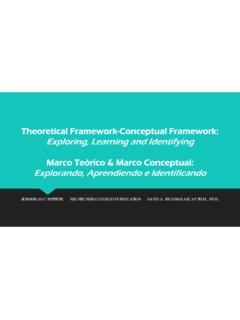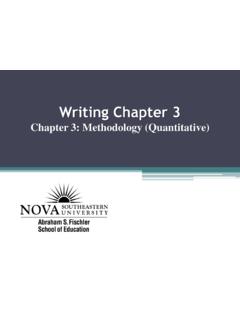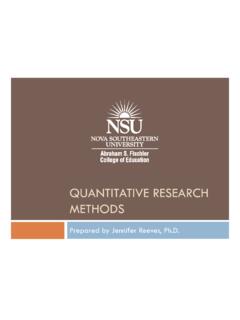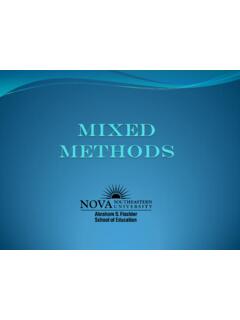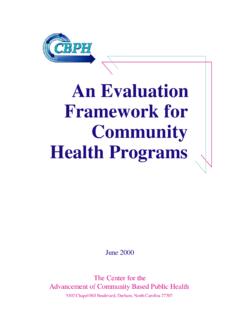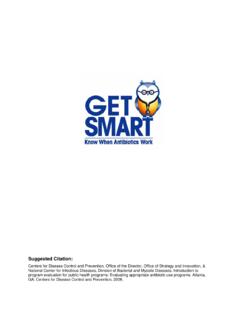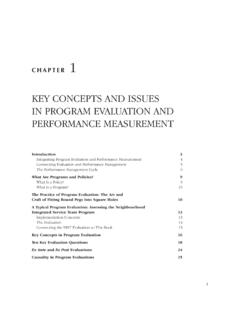Transcription of Program Evaluation: An Introduction
1 Program evaluation : An OverviewTopics General Ideas and Definitions Purposes for Program evaluation Program evaluation Standards Logic Models Defined Use of Logic Model to Develop evaluation Plan Example of Logic Model s Use in evaluation Planning Major Types of Program evaluation Models Explanation of CIPP Program evaluation Model What gets measured gets done. If you don t measure results, you can t tell success from failure. If you can t see success, you can t reward it. If you can t reward success, you re probably rewarding failure. If you can t see success, you can t learn from it. If you can t recognize failure, you can t correct it. If you can demonstrate results, you can win public D., & Gaebler, T. (1992). Re-inventing government. New York, NY: Accountability EraProgram evaluation Defined evaluation : Systematic investigation of the value, importance, or significance of something or someone along defined dimensions (Yarbrough, Shulha, Hopson, & Caruthers, 2011, p.)
2 287). evaluation is the systematic process of delineating, obtaining, reporting, and applying descriptive and judgmental information about some object s merit, worth, probity [moral correctness], feasibility, safety, significance, or equity (Stufflebeam & Shinkfield, 2007, p. 698).. the identification, clarification, and application of defensible criteria to determine an evaluation object s value (worth or merit) in relation to those criteria (Fitzpatrick, Sanders, & Worthen, 2004, p. 5). Program evaluations can involve ongoing monitoring of programs , or one-time studies of Program processes, outcomes, and/or Program of Program evaluation Who needs this evaluation and why? Clearly define the purpose for the evaluation . What questions need to be answered? What do the stakeholders want to know? Who is going to use the evaluation results?FormativeEvaluation Formative evaluations help strengthen or improve the Program . The more innovative a Program , the more likely the evaluation will uncover processes and other information for Program Evaluations Help determine what works best Accept the fact that negative results are valuable because they teach you something Provide feedback for improvement Do not use experimental designs but allow for interaction and observation Used most often with new programsSummative evaluation Summative evaluations examine the overall quality and outcomes of a Program .
3 These evaluations are conducted for decision-making purposes and determine whether the Program has met its intended outcomes relative to its cost. Summative evaluations are usually done for established programs and completed projects and conducted by outside and Summative Both formative and summative evaluation are needed in the development of a product or service.. Too often, summative evaluation is carried out only for judging programs .. This restricts development processes. (Stufflebeam & Shinkfield, 2007, p. 24). Program evaluation Standards The Joint Committee on Standards for Educational evaluation , 1994; Yarbrough, Shula, Hopson, & Caruthers, 2011 Identified five major attributes and 30 standards to guide evaluations Program Standards: Five Attributes Ensure the evaluation Will: be realistic, prudent, diplomatic, and frugal; increase evaluation effectiveness and efficiency. (FEASIBILITY) serve the information needs of the intended users. (UTILITY) Increase dependability and truthfulness of evaluation representations, propositions, and processes.
4 (ACCURACY) Program Standards: Five Attributes Ensure the evaluation Will: Support what is proper, fair, legal, right and just in evaluations. (PROPRIETY) Encourage adequate documentation of evaluations and a metaevaluative perspective focused on improvement and accountability for evaluation processes and products. ( evaluation )A logic model is your Program ROAD MAP-University of Wisconsin-Extension-Cooperative ExtensionWhere are you going? How will you get there?What will tell you that you havearrived? LOGIC MODELING: A PLANL ogic ModelWhat it is: An advanced organizerfor designing evaluations. Logic models are flowcharts that depict Program it is not: A theory An evaluation model or methodLogic Modeling A diagram of the theory of how a Program is supposed to work a graphic depiction of relationships between activities and results A logic model is a logical chain of connections showing what a Program intends to accomplish Core of planning and evaluationBenefits of Logic Modeling The process of developing logic models can serve to clarify Program elements and expectations for your stakeholders.
5 By depicting the sequence and logic of inputs, outputs, and outcomes, logic models can help ensure that the necessary data are collected to make credible statements of causality.(Continues)Benefits of Logic Modeling Provides a common language Helps us differentiate between what we do and results outcomes Increases understanding about Program Guides Program evaluation design and methodology Leads to improved planning and management (Continues)Benefits of Logic Modeling Increases intentionality and purpose Guides prioritization and allocation of resources Helps to identify important variables to measure; use evaluation resources wisely Supports replicationUse of Logic Model to Develop evaluation Plan Identify the Program s components: Program s rationale/design, (Input) goals and/or objectives or desired outcomes for a target population, (Input) intervention(s) or process(es), and (Outputs) Results, Impact (Outcomes) Look for the extent to which the Program s objectives include four elements: ( , what, when, how much)How to Develop an evaluation PlanUsing Logic ModelingDraw Links (arrows) Showing How Program is Supposed to workNote.
6 Relationships between activities and resultsModel shows a logical chain of connections How to Develop an evaluation PlanUsing Logic ModelingMay Identify AssumptionsMay Identify ExpectationsGraphic Organizer ofProgram ComponentsHow to Develop an evaluation PlanUsing Logic ModelingMay Identify AssumptionsMay Identify ExpectationsGraphic Organizer ofProgram ComponentsProcessesOutcomesImpact PrioritiesNeedsStaffMoneyPartnersDevelop ed inclusion training workshopConducted training sessionsTeachers increased their knowledge of inclusionTeachers better understood their own teaching style Teachers implemented effective classroom strategiesImproved teaching styleResearchINPUTSOUTPUTSOUTCOMESP rovided mentoringTeachers gained skills through practice in effective teaching strategiesApplication of Logic Model in Eval. PlanningTeachers identified appropriate actions to takeIncreased classroom success of children with special needsTargetedteachersattendedSITUATION:D uring a school wide needs assessment four years ago, the majority of teachers reported they were not well trained in inclusion.
7 They planned and implemented a set of activities to address the need. Short Intermediate LongAssumptions Formulate evaluation questions based on logic modeling Write questions reflective of the Program components you want to assess When writing the questions, consider how to collect the data needed to answer these questions. whether answers to the questions help those who will use the results of your evaluation ?Logic Model and evaluation Questions?StaffMoneyPartnersDevelop inclusion training workshopConduct training sessionsTeachers increase their knowledge of inclusionTeachers better understand their own teaching styleTeachers implement effective classroom strategiesImproved teaching styleResearchProvide mentoringTeachers gain skills in effective teaching practicesTeachers identify appropriate actions to takeIncreased classroom success of children with special needsTargetedteachersattendSample Questions: What do you want to know about this Program ?
8 More effective style? Greater student success?Behaviorschange? For whom? Why? What else happened?Knowledge and skills increase? For whom? Why? What else happened?Did all teachers attend that we intended? Who did/not not? Did they attend all sessions?Were all sessions delivered? How effectively?What amount of $ and time were invested?INPUTSOUTPUTSOUTCOMESP rogram investmentsActivitiesParticipationShortI ntermediateWhat we investWhat we doWho we reachWhat resultsLongBeware! programs Are Not Linear-University of Wisconsin-ExtensionFeedback Loops Once the Logic Model and evaluation questions have been formulated , determine the type of evaluation to conduct (formative and/or summative?) Which type or types of component analyses (context-design-input, intervention/process, outcome/impact, etc.) will provide the information for a formative and/or summative evaluation ? Can you meet the evaluation Standards and do you have the resources (time, money, etc.) to conduct the type of evaluation chosen?
9 Determine an evaluation Plan Program evaluations include more than 35 different types of models ( , needs assessments, accreditation, cost/benefit analysis, effectiveness, efficiency, goal-based, process, outcomes, etc.) Select the type that may address the formative and/or summative needs in the an evaluation Plan Objectives-based evaluation (Tyler, Popham, Steinmetz, Provus) Curriculum evaluation Model (Popham) Formative and Process evaluation Model (Royse, Tyler, & Padgett) Participatory-oriented evaluation (Guba & Lincoln, Patton, Stake) Decision/Accountability-oriented Evaluations (Stufflebeam CIPP)Major Types of evaluation PlansObjectives-oriented evaluation Model Examines Program s objectives to determine whether they have been achieved Conducted internal to organization Has narrow focusCurriculum evaluation Model (Popham) Prompted by Popham s criterion-reference assessment Cutting edge of education evaluation in 1990sMajor Types of evaluation PlansMajor Types of evaluation Plans.
10 Formative and Process evaluation Model (Royse,Thyer, & Padgett) Addresses Program implementation according to plan Assesses whether strategies and activities delivered as planned Examines whether benefits reached participants Seeks participants feedback and opinionsParticipant-oriented evaluation Prompted by naturalistic inquiry Includes participants as active players Has created controversy in the field Costs and labor intensity are problems Includes stakeholders who are left out of evaluationDecision/Accountability-orient ed evaluation (Stufflebeam CIPP) The basic purpose of decision-and accountability-oriented studies is to provide a knowledge and value base for making and being accountable for decisions that result in developing, delivering, and making informed use of services that are morally sound and cost-effective.. evaluation s more important purpose is not to prove but to improve.. Approach is applied both formatively and summatively (Stufflebeam & Shinkfield, 2007, p.)


